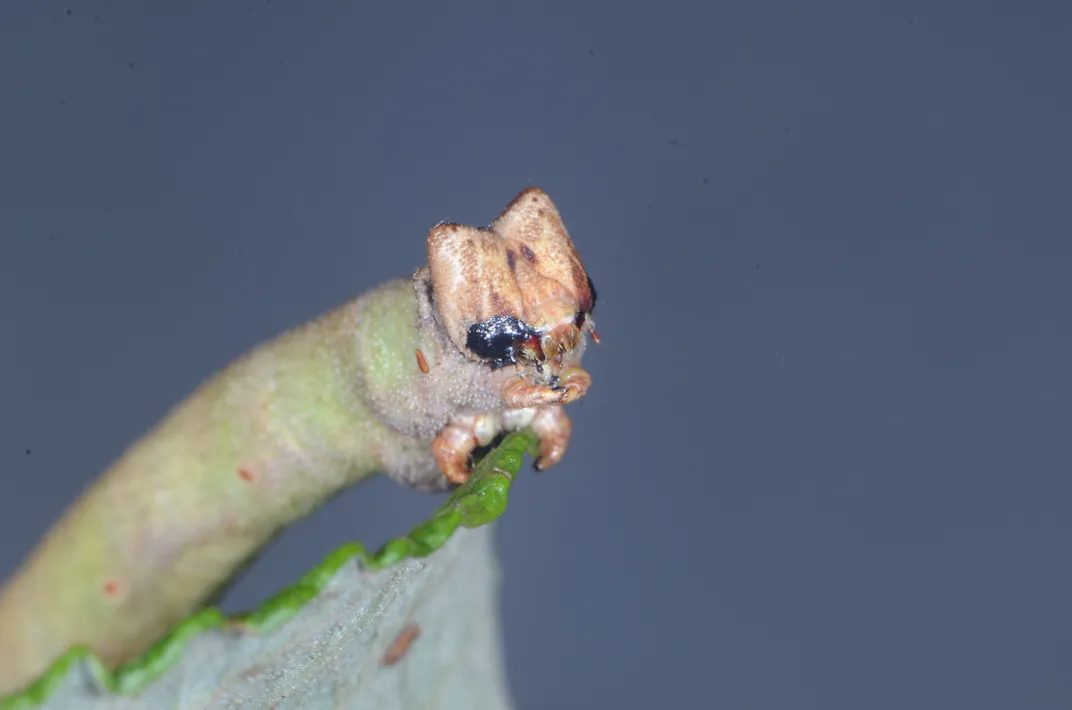These Caterpillars Can Detect Color Using Their Skin, Not Their Eyes
In experiments, peppered moth caterpillars successfully camouflaged themselves even when blindfolded
/https://tf-cmsv2-smithsonianmag-media.s3.amazonaws.com/filer/ab/61/ab61cd8b-7d6b-4815-82f7-605d5e29d817/207815_web.jpg)
Prior to the Industrial Revolution, most peppered moths sported speckled white coloring that enabled them to blend in with lighter-hued trees. But as increasing levels of air pollution darkened trees with soot, the moths adapted, adopting darker coloring to better correspond with their environment. Today, peppered moths—and their larval caterpillar counterparts—are so adept at camouflage that they can adjust their appearance to match the specific shade of the twigs on which they perch.
A new study published in the journal Communications Biology adds another dimension to the species’ already impressive color-changing abilities. As scientists led by Amy Eacock, a postdoctoral researcher at the Max Planck Institute for Chemical Ecology, reported earlier this month, peppered moth caterpillars can soak in their surroundings and shift shades accordingly even when blindfolded. In short, the team explains, the larvae can “see” with both their eyes and their skin.
Per Science’s Lakshmi Supriya, Eacock and her colleagues gauged more than 300 caterpillars’ color-sensing skills by placing them in boxes containing wooden dowels painted black, brown, green and white. Some specimens had an unimpeded line of sight, while others were temporarily blindfolded with black acrylic paint. Ultimately, around 80 percent of the larvae—both blindfolded and not—opted to rest on sticks most closely matching their body coloring. (This strategy is more efficient than shifting one’s own color to blend in with surroundings; as Eacock notes in a blog post, changing color is “energetically costly” and can take upwards of a week.)
According to Eacock, the same pattern proved true when the researchers placed caterpillars on dowels of different colors, with blindfolded subjects changing color to match a given twig at the same rate as their non-blindfolded peers.

Ilik Saccheri, an ecological geneticist at the University of Liverpool and co-author of the study, tells the New York Times’ Cara Giaimo that he was initially “a bit disbelieving” regarding larvae’s ability to change color accurately using only their eyes, which are relatively simple at this stage in development.
To better understand the mechanics behind the species’ chameleon-esque appearance, Eacock, then a graduate student in Saccheri’s lab, tested caterpillars’ eyes and skin for light-sensitive proteins known as opsins. Crucially, she explains to the Times, the analysis showed opsins “were expressed in the skin as highly as they were in the head,” providing the team with the evidence needed to launch a more in-depth investigation.
Per Eacock’s blog post, the scientists believe peppered moth caterpillars evolved the ability to sense color with their skin in order to gain more accurate visual information—perhaps, for example, when resting with their head turned away from a twig. Overall, this adaptation enables larvae to better shield themselves from avian predators.
For now, it remains unclear exactly how the caterpillars receive and employ color information. Still, Martin Stevens, a sensory and evolutionary ecologist at the University of Exeter who was not involved in the study, tells the Times, the study represents “the most complete demonstration so far that color change can be controlled by cells outside the eyes.”
/https://tf-cmsv2-smithsonianmag-media.s3.amazonaws.com/accounts/headshot/mellon.png)
/https://tf-cmsv2-smithsonianmag-media.s3.amazonaws.com/accounts/headshot/mellon.png)